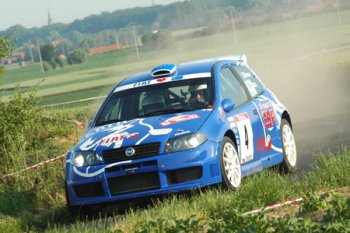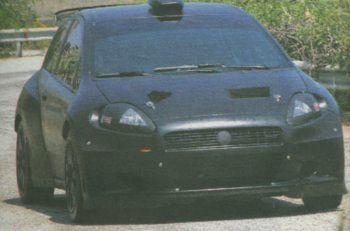|
Two weeks ago
the first spy photographs of the new Fiat Grande Punto 'Super 2000'
rally prototype broke cover - courtesy of Italian magazine
SAM (SportAutoMoto) Rally - now we present a closer
analysis of the new rally car, courtesy of the same
publication.
Fiat - along
with up to eight other car manufacturers - are at present
developing a rally car for the FIA's proposed new 'Super
2000' regulations. These new rules effectively call for
costs to be tightly controlled - to stem the haemorrhaging of
manufacturers away from rallying - and are to be essentially
based on the successful 'Super 1600' class regulations. The
biggest changes foreseen will be in the area of engine
capacity, which will be raised to two litres, and the
addition of four wheel drive - both factors that will allow
the proposed 'Super 2000' category to form the basis of a
future top-line class, and let the new cars be exciting and
dramatic to watch for the rally fans. Keeping the cars'
weight limit restricted to 1,100kg along with a strict
control on the use of 'driver electronic aids' will help to
create a new breed of potent new rally machines.
The first 'spy'
photos of the lightly disguised new Fiat Grande Punto Super 2000'
prototype taken at Balocco - with project test driver Paolo
Andreucci behind the wheel - offer some hints of the overall
technical theme being developed. It is noticeable that only
two images have emerged - and both of these are essentially
frontal views, which hide the rear, and mask much of the
side areas. The car - which is not shown travelling at any
great pace - is obviously in a very early development stage
(in fact it is currently using a 2.0-litre powerplant
'borrowed' from the FIA World Touring Car
Championship-contesting Alfa Romeo 156 racer which is also
built and developed by N.Technology) as there is no
exaggeration visible to the front camber angle, meaning that
the set-up is still a long way from being fine tuned.
The rear wheel track has been extended right to the
proposed new limit of the 'Super 2000' rules, and is clearly
wider than the front one. This presents a first look at the
power distribution of the new category, which is expected to
see the bulk of power being transferred through the rear
wheels. SAM Rally also point out the
tarmac-specification tyres chosen for the test by Engineer
Adamo - the N.Technology Fiat Grande Punto Super 2000 project
manager - for this test suggest that the visiblr 'footprint'
means that between 260 and 280 bhp of power can be
transferred to the wheels.
|
 |
|
The first stage of
Fiat's return to top-flight rallying has got
underway this year with a three-pronged challenge
with the Super 1600 Punto: Micro Baldacci in the
JWRC, Giandomenico Basso in Europe (above) and
finally Paolo Andreucci in
Italy |
|
|
 |
|
The first 'spy' photos of the lightly disguised new
Fiat Punto Super 2000' prototype taken at Balocco
offer hints of the overall technical theme being
developed. Photo: SAM Rally. |
|
|
The larger front brakes are fed with dedicated small cooling
air intakes. The bulbous front wheel arches stop precisely
at the doors: the exact point where the hot air generated by
both the front brakes and the engine exit. The muscular new
styling of the car is used in essence only to expel heat -
this is very much the trademark of N.Technology's chief
engineering - Sergio Limone - who prefers to concentrate his
efforts in the area removing the hot air generated more
effectively, rather than aiming to push in more cold air.
The Grande Punto 'Super 2000' prototype features no outrageous
front spoiler arrangement - which implies that aerodynamic
studies carried out in the wind tunnel have been very
effective, even in relation to the 'road going' Fiat Grande
Punto, itself designed to offer an excellent segment drag
co-efficient.
The lower bordered front splitter has been carefully
designed, and it receives its load without making
excessively dirty the front section. In the centre it
exploits an air channel which feeds towards the lower part
of the car, in order to deploy to the optimum the flows
which then are moved to the rear. While this is a
provisional solution, it is clear that N.Technology's
engineers are not searching for any increased front loads,
and that it is an arrangement coherent with a power balance
that is distributed with a prevalence firmly biased toward
the rear axles.
The high-level rear wing is basically quite small, and it
seems to accurately resemble a required airflow deviator,
which is needed to augment the prototype's aerodynamic
penetration, while at the same time helping to decrease the
braking vortexes, which tend to form their shape behind the
rear window.
The front air ducts aren't particularly large (as we have
come to expect from the WRC category) and the bonnet intakes
doesn't draw in too much air either, and have no facility
for removing any exhaust air at all. Meanwhile at each side
of the front headlamps N.Technology's design team appear to
have developed a new cooling intake. These facts confirm
that there isn't an excessive amount of power available, but
that power which is 'on tap' is carefully used, because the
need to cool the mechanicals isn't deemed to be priority.
by Marco Tenuti / based on a feature from SAM Rally
|
|
|
|
![]()
![]()